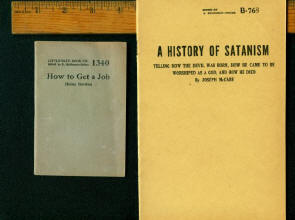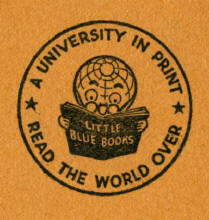|
Little Blue Books Big Blue Books
|
||
|
back cover
|
In 1919, Emanuel Haldeman-Julius and his wife, Marcet, worked for a socialist newspaper in Girard, Kansas. They decided to buy the operation; but far more important than the press itself was their circulation list, containing 175,000 names and addresses. They sent out letters to every name on the list with an offer: for $5, a subscriber would receive 50 books in the coming year. 5,000 people took him up on the offer, and with $25,000 in the bank, they very quickly printed the first fifty books. It took them until 1923 to settle on the name "Little Blue Book," going through a string of monikers before they did so. By this time, most of the books were some color other than blue, but the name stuck. By 1928, they were becoming a part of American culture. He got endorsements from people like Richard Byrd, who took a box of them on his South Pole expedition. People were calling Haldeman-Julius "the Henry Ford of Literature," for bringing us books that were affordable to the common man. I can find no information on the "Big Blue Books," but I assume they sold for a dime. There are no more pages, but because of the paper size, the printed content was much longer. Their book numbers were preceded by a "B-." By the outbreak of WWII, J. Edgar Hoover had branded Haldeman-Julius a communist, which obviously hurt subscription levels. Haldeman-Julius died in 1951, but the press was kept running by his sons at a low output until the press building and warehouse burned in 1978.
|
|



